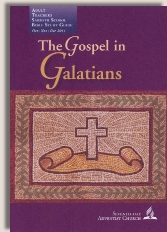|
||||||||||||||
Commentary on "The Priority of the Promise"
Day 2: Sunday, October 30, 2011 - Law and Faith
Overview
Undoubtedly this is the best part of this week’s lesson, because it rightfully identifies the kind of covenant God made with Abraham, a covenant based exclusively on God’s will without “ifs, ands, or buts”, in contrast with a usual covenant based on mutually agreed promises. He highlights that this promise, as in the case of a will, cannot be changed by the law when it is introduced 430 years later, and the covenant with Abraham is going to remain in force.
Observations
All the above ideas are found in Galatians 3:15-18, the biblical texts offered as proof for the argument. The reader is left wondering where the author is going to do a thorough commentary of these verses, since in the following sections of the lesson the author moves forward in Galatians 3 without coming back and finishing the argument Paul presents in these verses. He acknowledges that the promise of the Abrahamic covenant involves an inheritance and also a specific beneficiary, Abraham and his offspring, but he doesn’t mention the important fact that Paul identifies Abraham’s offspring with Jesus Christ on the basis of the singular versus the plural number of the word “offspring” in Genesis. This minor detail is highly important in order to understand Paul’s flow of thought in the entire explanation dealing with the relationship between the one-sided promise-covenant-will made with Abraham with no conditions and the Mosaic covenant which was full of conditions.
In Paul’s thought, Abraham’s offspring has a double meaning: Christ and also the individual offspring of Abraham, Jews and gentiles alike (Gal. 3:29). The second meaning derives from the first: being united with Christ Jesus in faith, the believer is identified with Jesus, one with him. From now on, what is true of Christ is true also of the believer. Jesus is the offspring of Abraham, the one to whom God promised an inheritance. Jesus Christ’s coming became the temporal moment when God fulfilled His promise made to Abraham’s offspring. That moment is a thing in the past, a temporal moment significant for the history of salvation because it is relevant to the relationship between promise and law, the Abrahamic and the Mosaic covenants. The fulfillment of the promise to Abraham in the person of Jesus constitutes a culmination of the Abrahamic covenant which is no longer a promise looking forward for a time of fulfillment, but now is an accomplished fact. Because what is true of Jesus Christ is true of those who are in Him (Gal. 3:27-29), the fulfillment of the promise becomes a reality in the lives of the individual believers. While there is a basic continuation of the way God deals with his people before and after the cross, while faith is the means of inheriting the benefits of God’s promise either before or after the “Jesus moment”, there is something new, something definitive, something final—the object of the promise becoming reality.
This kind of shift is a watershed that unfortunately is missing from the Adventist perspective, and this lack is specific to Adventist theology. The difference between Adventist theology and variations of Christian theology that recognize God’s way of salvation was always through faith in His promise, is that in the Christian perspective the coming of Jesus has the importance of an earthquake that moves everything into a new place. His life, death, and the newness of fulfillment brought by His resurrection are exactly the things that, from an Adventist perspective, are under-evaluated, underestimated, and under-appreciated. While acknowledging their historical truth, Adventists, from a practical point of view, still understand these things to be in the future; God’s promise is still waiting for its fulfillment. The definitive, final, once for all character of God’s redemption and the identification of the believer with it are still in the future.
Copyright 2011 BibleStudiesForAdventists.com. All rights reserved. Revised October 29, 2011. This website is published by Life Assurance Ministries, Glendale, Arizona, USA, the publisher of Proclamation! Magazine. Contact email: BibleStudiesForAdventists@gmail.com.
The Sabbath School Bible Study Guide and the corresponding E.G. White Notes are published by Pacific Press Publishing Association, which is owned and operated by the Seventh-day Adventist church. The current quarter's editions are pictured above.
Official Adventist Resources
Standard Edition Study Guide Week 6
Teacher's Edition Study Guide Week 6
Easy Reading Edition Study Guide Wk 6
Search the Complete Published Ellen G. White Writings
Please Support This Project


